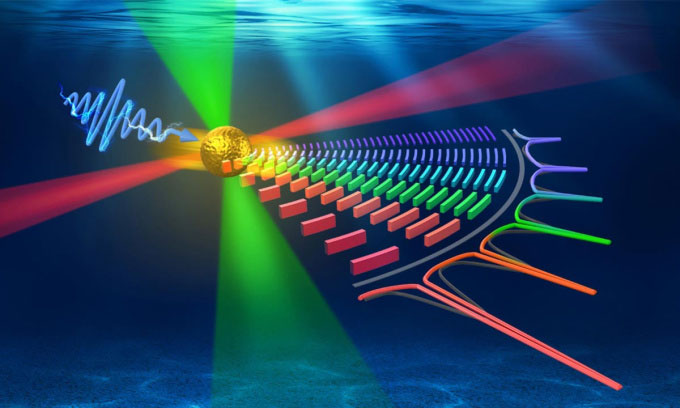China develops super powerful acoustic laser technology
Acoustic lasers are created by manipulating phonons, and have great potential for applications in medicine and deep-sea exploration.
Chinese scientists have made a major step forward in developing a more powerful laser that uses sound waves instead of light , SciTechDaily reported on October 4. The new research was published in the journal eLight.

Sound is produced inside a tiny sphere of silicon dioxide. (Photo: IFL Science).
Conventional lasers are interesting in their own right. They were first created by humans in the 1960s. "Lasers produce a narrow beam of light in which all the light waves have very similar wavelengths. The light waves of a laser travel together, their peaks all aligned, or in phase. This is why laser beams are so narrow, so bright, and can be focused to a very small spot ," NASA explains.
Although sound and light have differences, physicists have worked to create acoustic lasers by manipulating phonons.
'Similar to the photons that make up a beam of light, phonons — indivisible quantum particles — make up a beam of sound. These particles arise from the collective motion of trillions of atoms, like the 'stadium wave' in a sports arena from the motion of thousands of fans. When you listen to a song, you're listening to a stream of these tiny quantum particles,' explains Andrew N. Cleland, a professor at the Pritzker School of Molecular Engineering at the University of Chicago.
Originally used to explain the heat capacity of solids, phonons were predicted to obey the same quantum mechanical rules as photons. However, the technology to produce and detect phonons still lags far behind that of photons.
Previously, phonon lasers were made from small objects that were affected by weak and imprecise sound waves, which limited their usefulness. The new method overcomes this problem by 'locking' the sound waves into a more stable and powerful state.
In the new study, the Chinese team took a silicon oxide (SiO 2 ) microsphere and suspended it with beams of light. This caused the sphere to vibrate, creating a beep-like sound inside that was so high-pitched and loud that it exceeded human hearing. Next, they began to manipulate the microspheres with an alternating electric field to create resonance, amplifying the sound waves at those frequencies by 1,000 times.
The experiment was conducted in a vacuum to better measure the sound waves (which are confined inside the microsphere), bringing it closer to creating acoustic lasers that could be used for everything from exploring and mapping the oceans with sound to improving medical imaging techniques. Acoustic lasers could also have applications in materials science, quantum computing, and more.
- Russia built the world's most powerful laser super
- China aims for laser submarines that move at the speed of sound
- The US military develops laser weapons that can burn targets from a distance
- Laser 1000W laser gun has been born, 10 times stronger than standard
- China synthesizes a new crystal, producing a laser 13 times stronger than the old technology
- Laser: From the movie 'Star Wars' comes true
- Using a laser to create rain, control the weather
- X-ray laser machines are a billion times brighter than today's machines
- The US Navy equipped a laser gun that destroyed super accurately
- New Chinese laser guns can burn skin in 1 second at 800 meters
- Glasses against laser
- Russia is building the world's most powerful laser
 The US company is about to build a supersonic passenger plane of 6,000km / h
The US company is about to build a supersonic passenger plane of 6,000km / h Japan develops avatar robot as in fiction film
Japan develops avatar robot as in fiction film Australia tested the world's first mango picking robot
Australia tested the world's first mango picking robot America develops technology to separate water from animal waste
America develops technology to separate water from animal waste